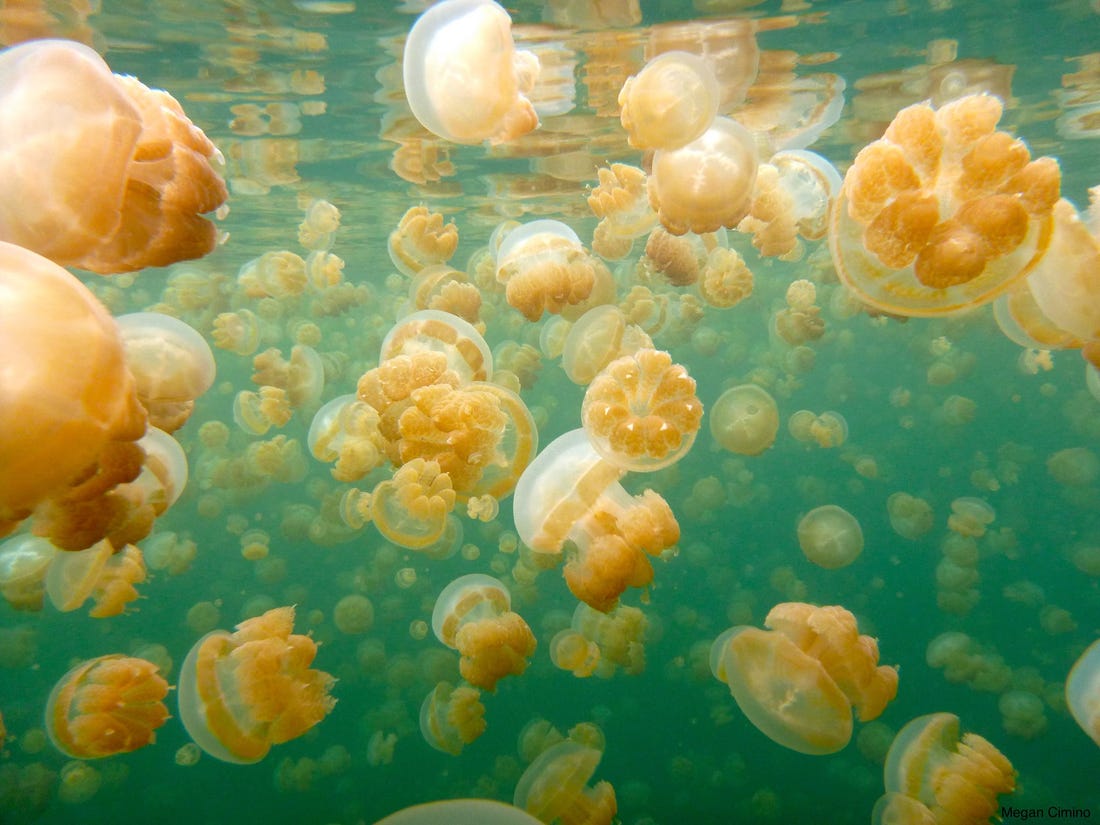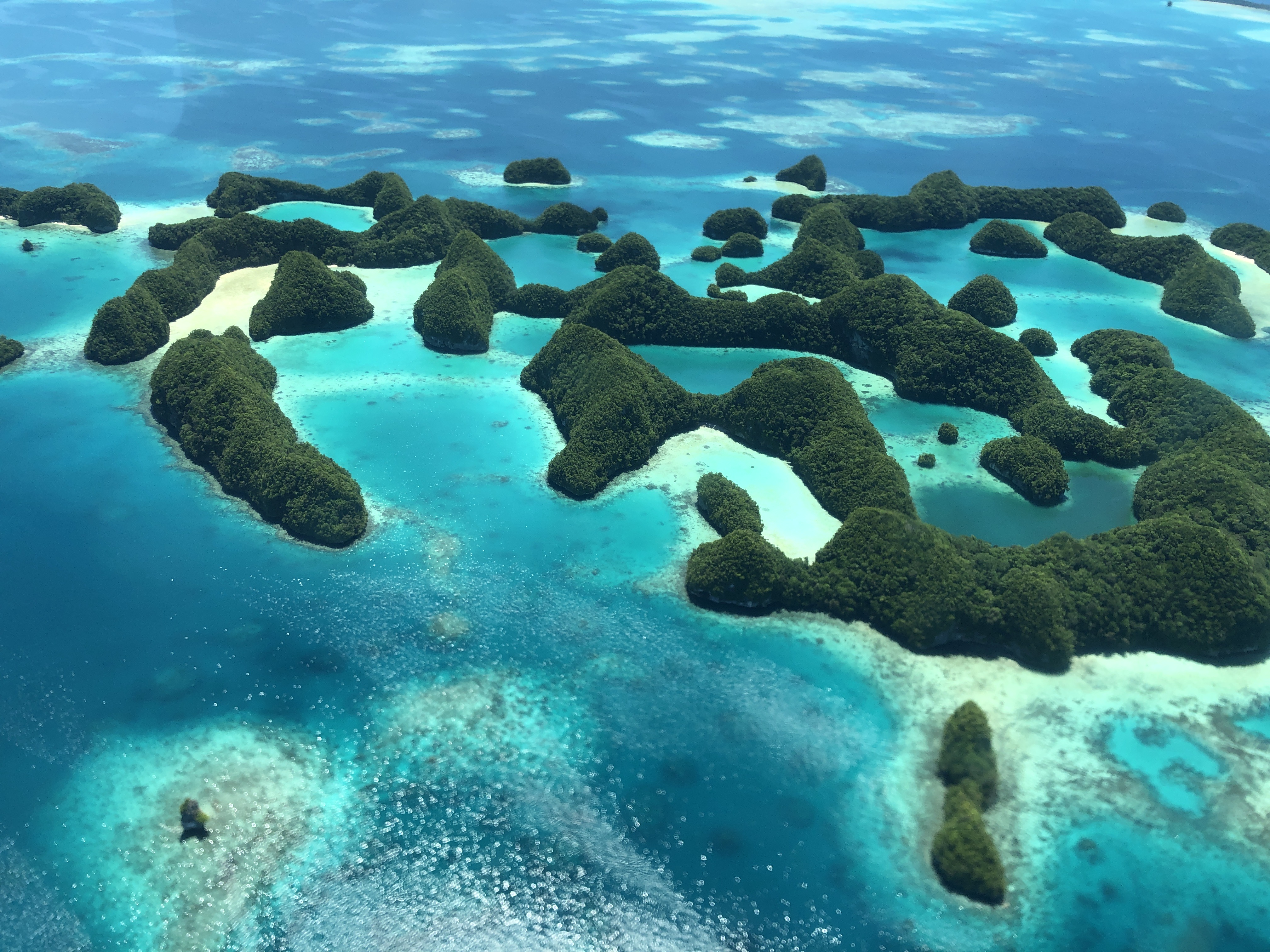

The main highlight of visiting Palau would be to swim with jellyfish. Yes, the Jellyfish Lake in Palau is a UNESCO World Heritage site, and it is possible to swim with thousands of jellyfish without being stung. Palau offers an incredibly high diversity of marine species and its pristine marine habitats support some of the world’s richest populations of corals, fish, and other invertebrates. This was why we sacrificed our long weekend to make a trip to Palau to enjoy the beauty of the marine life.
There are many tour companies that offer this day tour and we chose to go with Sam’s tours, one of the more reputable companies. Sam’s tours also offer other tours such as kayaking, diving etc. Sam’s Tours is an award winning shop, renowned for top-notch customer service. A 100% Palauan owned dive center, Sam’s Tours is a key player in the local community while continuing to strive to offer our guests the incredible experience that awaits in Palau’s magnificent reefs.

After making payment at the office, we were given a receipt to collect our fins and snorkel gear. We then boarded the speedboat which would take us to the Rock Islands for our day tour. Before coming to Palau, I thought it would be possible to do Jellyfish Lake on our own, the backpacking way. However, there are no roads leading to the lake, so travel by boat is the only way and it is compulsory to join a local tour company. The cost of our tour is US$108 (after a 20% discount) and the necessary jellyfish lake permit at US$100 (valid for 10 days). So most people make use of the permit to do diving around the area on subsequent days.
The Rock Islands is comprised of 445 uninhabited limestone islands. Covered in vegetation right to the waterline, these green islands, vertically erected from the water, create a labyrinth in perfectly calm turquoise lagoons, with hidden marine lakes, rocky arches, caverns and rich coral reefs.

Our first stop was the arch of Palau. Some call it the Eiffel tower of Palau, the Arc de Triomphe while others call it the the Lover’s Bridge. It is a natural reef in the Rock Islands, which has been eroded by the sea for many years and has formed a sea arch. It looks like a stone bridge in the natural sea. This is the best place for tourists to snorkel, because there are beautiful corals below the sea level, and the visibility of the sea is very high. It is absolutely a diving paradise.

There was a snorkelling site known as ‘Paradise Corner’ where we snorkeled with hundreds of colourful fishes. The visibility of the water was really good and without the need to dive several metres underwater, we were able to see such a diverse marine life. I also saw a small reef shark and other types of fishes.

The next stop brought us to the German channel. It was built by the Germans of course, before WWI. This man-made passage was created by the Germans during an occupation about a century ago, so they blew up the coral reef in order to make a shorter route for their boats to pass through the region. Right now, if you visit during this period (Nov to Jan) there’s a good chance to see some mantas along this channel. However, the German channel is not a suitable place for snorkelling because of the high volume of traffic.

At the next lagoon, we managed to snorkel a second time. The coral reef had a steep descent at this place and it was also teeming with marine wildlife.

At our third stop, we paused for our lunch break. In a bid to be environmentally friendly, Sam’s Tours uses bento boxes which can be reused everyday. We did not have a choice of food, but the Japanese style chicken karaage and teriyaki grilled chicken tasted so delicious. We had expended our energy during the two snorkels previously and devoured our lunch quickly.

After lunch, we had some time, so we could wander along the beach and take some photos of the scenery. The beach was experiencing low tide, so we saw several black, elongated objects on the beach. Don’t worry, it is not human waste. These black organisms are actually sea cucumbers. They felt squishy and flaccid. Being good Samaritans, we helped to put the sea cucumbers into the ocean so they would not dry up and die. It was surreal to teach these live sea cucumbers, like the ones we felt at the Okinawa aquarium.

After lunch, we headed to a snorkel spot with giant clams. These clams were apparently left behind by a farmer and they multiplied quickly without human interference. Next up was the eagerly awaited Jellyfish Lake. As a drought in 2016 killed most of the jellyfish and the lake was only recently reopened to the public, the government was very strict about people visiting the lake. Besides the US$100 permit to enter which they checked thoroughly, we also had to wipe off any visible sunscreen on our bodies as it may harm the jellyfish. Each person also had to bring along a life jacket.


The Jellyfish Lake is isolated from the ocean; though it is still connected through the tunnels and fissures of the limestone of Rock Island (more specifically the island of Mecherchar). Do you know that it’s also prohibited to dive within the lake? Well the 30m deep lake composed of 3 layers: the oxygenated layer which we find the jellies, the mid oxygen-depleted layer filled with bacteria, and the last layer filled with hydrogen sulfide which is non-diver-friendly. The lake is so huge, so the jellyfish will migrate across the lake during the day.

Due to the lack of natural predators (only the anemones by the lake’s ‘shady’ areas) and in pure isolation, these jellyfish have evolved over tens of thousands of years to become ‘stingless’ (actually, they still have sting, just that it is too mild to affect humans). Everyday, they migrate with the direction of the sun within the lake so as to photosynthesize, and by night time, they cross to the other side of the lake awaiting a new day. We had an awesome time swimming with the non-stinging jellyfish, admiring their graceful movements in the water and also taking countless photos or videos to our heart’s desires.


Our last stop of the day was to the ‘Milky Way’. No, do not mistake it for the stars. This place is like a natural island spa, where sulfur sand fizzes through the rock, offering you the most natural skin scrub even the most luxurious beauty salon cannot deliver. We covered our bodies with the exfoliating mud generously, then jumped into the waters to wash it off. It was really invigorating and my skin felt smoother after this treatment. The best part of this is that it is free! There were even stories of people selling the mud in small bottles at $50 each, even though it is illegal to smuggle anything out of the islands due to their protected conservation status.

After being dropped off at our original point, we were whisked by van to our next tour – the night kayaking with RITC. They charged US$52 for the night kayaking tour with dinner included and also swimming with phytoplankton. My friends were really excited to swim with the glow-in-the-dark plankton, but for me I had already done such a tour in Thailand. Nevertheless, this night tour was beautiful as well because we were kayaking into the sunset. The guide at RITC was also friendly and he pointed out some species of flowers and plants found only in the Rock Islands, while we were kayaking.

When night fell and everything became pitch dark, except for the headlights of the boat where we had our dinner at. It was drizzling but that did not dampen our spirits. Our guide gave us the go-ahead to jump into the waters with our life jacket to admire the phytoplankton. By kicking or moving our hands, the plankton started to ‘light up’, making it appear like a thousand stars in the sea. It was indeed a magical moment for all, but unfortunately we could not capture the photos on our devices. To end off, we slowly paddled our way back to the pier, through the darkness and the towering limestone cliffs which are now not so visible during the night. It was a long day filled with tours, but we were satisfied and appreciated the marine life of Palau even more.




